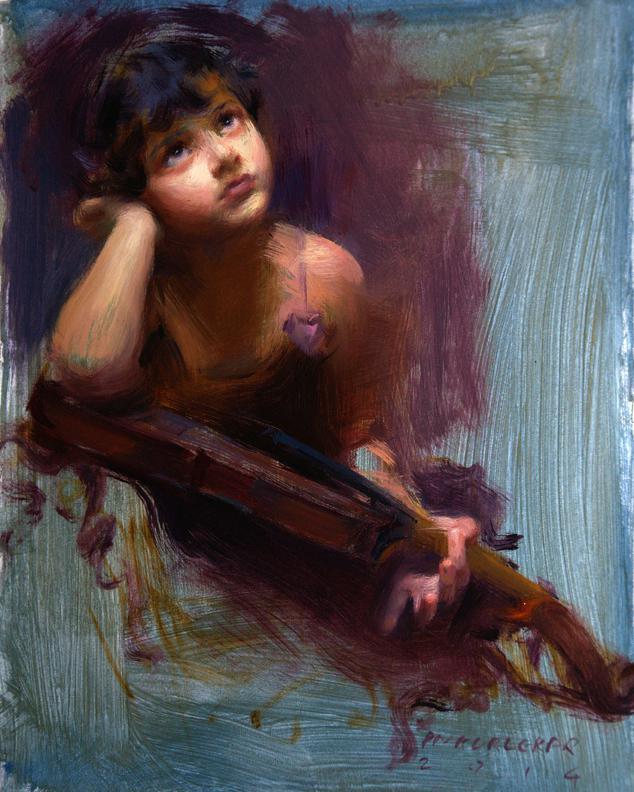Why Figurative Oil Painting Remains an Ageless Choice for Artists
Wiki Article
The Duty of Feeling and Expression in Figurative Oil Painting: A Comprehensive Evaluation of Subject and Structure
The interplay of feeling and expression in figurative oil paint serves as a critical lens via which one can take a look at the intricate partnership between subject issue and composition. Artists harness different strategies, from shade choice to brushstroke characteristics, to cultivate psychological vibration within their jobs.Comprehending Feeling in Art
Emotion in art acts as an effective avenue for expression, allowing musicians to convey complicated sensations with their job. In figurative oil painting, this psychological depth is often represented through the depiction of the human number, capturing the nuances of human experience. The selection of topic, color scheme, and brushwork all add to the psychological vibration of a piece.Artists often attract upon individual experiences, social problems, or universal styles to stimulate sensations in the visitor. For instance, a picture might mirror vulnerability, while a vibrant figure in movement can represent flexibility or chaos. These psychological threads connect the audience to the artwork, promoting a discussion that transcends the visual medium.
In addition, the interaction between light and shadow can enhance emotional intensity, leading the viewer's gaze and accentuating particular elements within the structure. Using structure in oil painting further includes layers of intricacy, welcoming a responsive action that enhances the psychological experience. On the whole, comprehending emotion in art is vital for valuing the nuances that define figurative oil painting, as it transforms mere representation right into an extensive expedition of the human problem.
Crucial Element of Structure
In the realm of metaphorical oil painting, the composition works as the underlying structure that arranges visual components and enhances the emotional narrative. Crucial parts of make-up include balance, contrast, focal point, and rhythm, each adding to the general impact of the artwork.Balance describes the circulation of visual weight within the paint, which can be attained via balanced or asymmetrical plans. A well-balanced composition gives stability, allowing the viewer to involve with the piece sympathetically - figurative oil painting. Comparison, on the various other hand, involves comparing different components, such as light and dark or warm and amazing shades, to assist the viewer's eye and stimulate psychological responses
The prime focus is critical, as it guides interest to the most substantial part of the painting, frequently highlighting the emotional core of the narrative. Via methods like shade saturation or placement, musicians can highlight this location effectively. Finally, rhythm refer to the rep of aspects, developing a sense of activity and flow throughout the structure. By masterfully integrating these crucial elements, artists can craft engaging and psychologically resonant figurative oil paints that captivate and engage their audience.
Topic and Its Influence
Subject plays an essential duty in metaphorical oil paint, as it not just offers as the structure for the narrative however also shapes the visitor's analysis and psychological interaction with the art work. The option of topic-- be it a solitary figure, a group dynamic, or a thematic depiction-- straight affects the psychological atmosphere conveyed to the audience.
As an example, portraits frequently evoke individual connections, disclosing the complexities of human expression and character, while scenes illustrating communal activities can develop a sense of belonging or fond memories. Moreover, the social and historical context of the topic enriches the visitor's understanding, triggering deeper representations on societal norms, worths, and the human problem.
Various subject matters also create varying levels of involvement; a dramatic problem depicted with numbers in tension might evoke feelings of anxiousness or empathy, while serene landscapes can invoke harmony and contemplation. Eventually, the impact of topic in figurative oil painting is extensive, as it works as a channel for emotional resonance, guiding the audience's feedback and analysis, and fostering a connection between the art work and the viewer. This interaction is important for the effective interaction of the musician's intent.
Strategies for Stimulating Sensations
The efficiency of figurative oil painting in click to find out more communicating emotions is significantly influenced by the strategies utilized by the artist. Among the most important methods is the use of shade concept, where the tactical option of tones can stimulate details psychological reactions. Cozy colors, such as oranges and reds, usually evoke feelings of enthusiasm or aggression, while cooler tones like blues and greens often tend to evoke peace or unhappiness.Another crucial strategy is the manipulation of light and shadow, referred to as chiaroscuro. This technique enhances the three-dimensionality of figures, creating significant contrasts that can intensify emotional depth. The placement of light can guide viewers' feelings, highlighting details elements of the composition.
Brushwork additionally plays a crucial duty; loose, meaningful strokes can additional hints share power and spontaneity, whereas smoother methods might recommend peace or accuracy. Additionally, the arrangement of topics within the structure can influence emotional influence. Close distance can suggest intimacy, while range might indicate seclusion.
Ultimately, the mix of these techniques enables artists to craft narratives that reverberate with the customer, transforming a plain visual experience right into an evocative emotional trip. - figurative oil painting

Case Researches of Noteworthy Functions
Analyzing significant works of metaphorical oil paint reveals exactly how numerous methods are used to evoke powerful feelings. One excellent case is Edvard Munch's "The Scream," where the distorted number and swirling history convey existential dread. Munch's usage of color-- vivid oranges and deep blues-- intensifies the emotional effect, showcasing exactly how scheme choices can shape audience experience.An additional substantial job is Pablo Picasso's "Les Demoiselles d'Avignon." Here, strong brushstrokes and fragmented types show a troubled psychological landscape, challenging standard depictions of the women number. Picasso's cutting-edge make-up not only records the viewer's focus yet additionally welcomes contemplation on themes of identification and sexuality.
In Addition, Frida Kahlo's "Both Fridas" uses an emotional expedition of duality and self-identity. The different numbers, linked by a shared heart, exemplify Kahlo's emotional depth and individual narrative. figurative oil Continued painting. Her precise attention to detail and symbolic components serve to involve customers on a natural degree
These study highlight the profound connection between feeling and structure in figurative oil paint, exposing how musicians harness strategy to interact complex sensations and stories that resonate throughout time and culture.

Verdict
To conclude, the interaction of emotion and expression in metaphorical oil painting considerably enhances the customer's experience and analysis of the artwork. With a careful selection of topic and compositional techniques, artists share profound stories that reverberate on both individual and universal levels. The application of shade theory, chiaroscuro, and brushwork further intensifies emotional deepness, changing each canvas into an effective reflection of the complexities of the human experience.In figurative oil painting, this emotional depth is frequently represented through the depiction of the human figure, capturing the nuances of human experience.Moreover, the interaction in between light and shadow can magnify psychological strength, guiding the audience's look and attracting attention to certain elements within the structure. The use of appearance in oil paint additionally adds layers of complexity, inviting a tactile action that boosts the psychological experience.The focal point is essential, as it guides focus to the most substantial part of the painting, typically highlighting the emotional core of the narrative. Eventually, the effect of subject issue in figurative oil painting is profound, as it serves as a channel for psychological resonance, assisting the customer's action and analysis, and cultivating a link in between the art work and the viewer.
Report this wiki page